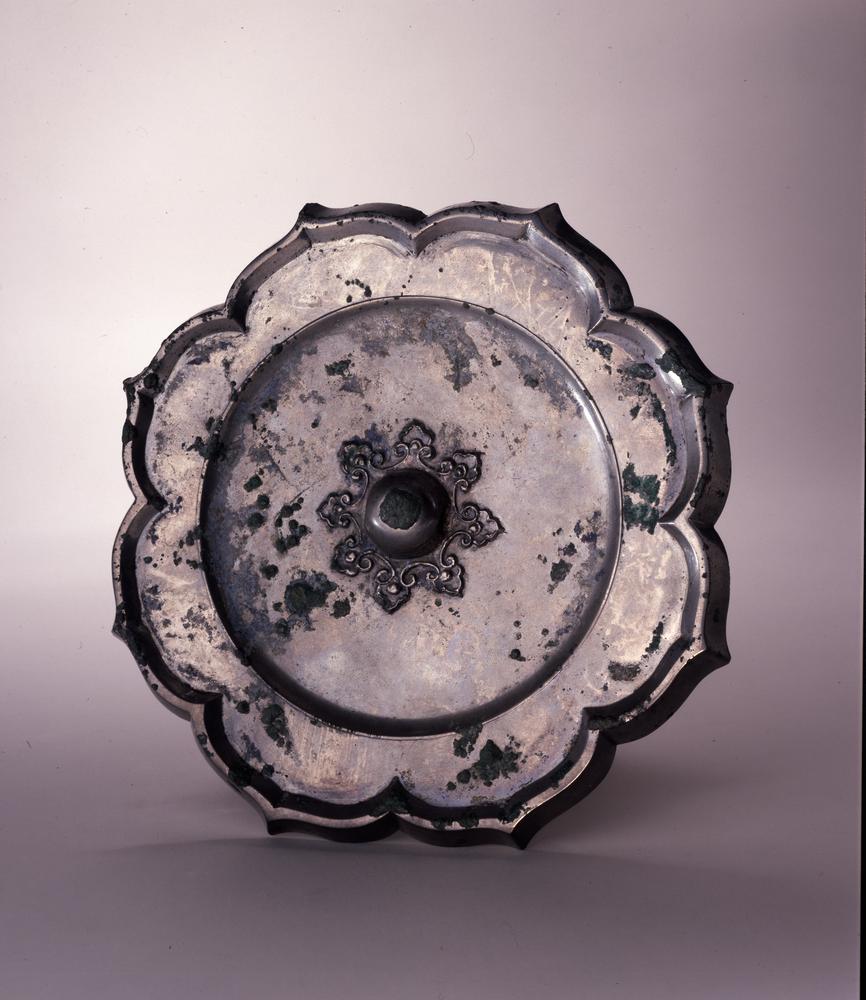Period:Tang dynasty Production date:701-850 (circa)
Materials:silk, 絲綢 (Chinese),
Technique:painted
Subjects:buddha equestrian palace/mansion 佛 (Chinese) 哺乳動物 (Chinese) 皇城 (Chinese) life of the buddha
Dimensions:Height: 40.50 centimetres (Images on silk) Height: 56 centimetres (In mount) Height: 18.50 centimetres (Individual images) Width: 20.20 centimetres (Images on silk) Width: 40.70 centimetres (In mount) Width: 17.60 centimetres (Individual images)
Description:
Finely painted banner fragment with two scenes from the Life of the Buddha, showing two of the Four Encounters made by Śākyamuni, as he leaves the palace on his white horse: old age (top) and sickness (bottom). Inscribed cartouches on alternate sides of the scenes. Ink and colour on silk.
IMG
![图片[1]-painting; banner; 繪畫(Chinese); 幡(Chinese) BM-1919-0101-0.88-China Archive](https://chinaarchive.net/Tang dynasty/Paintings/mid_00000033_001.jpg)
Comments:EnglishFrom Whitfield 1982:By its clear relationship with the preceding banner, this fragment, showing two of the Four Encounters (all four-Old Age, Sickness, Death, and the Religious Life-are shown on another banner in New Delhi), implies the existence of an orderly series of banners, presenting the events of Sākyamuni’s life in sequence.Much care was taken in the execution: unlike the inscriptions on many of the votive banners, the characters in the cartouches are neatly written, of a standard size and well chosen to fill the space available exactly. The style of the figures and of the architecture echoes this care. In both banners the architecture is drawn with slender elements, although not yet so attenuated as that of the side scenes of the south wall of Cave 25 at Yulin, where the columns have become truly pencil-thin. The figures and Sākyamuni’s horse are compact and beautifully organized within the space available. Although the overall impression, from colouring and setting, is very different from that of Pl.38, an examination of such details as the fine delineation of the bony structure of the horse’s head and the accurately drawn harness reveals a close similarity. The initial impression distinguishing the two may have much to do with the subjects: here and in Pl.34 it is the civilized and orderly background of the prince’s sheltered life in the palace of his father that is shown, while his new life as a religious ascetic begins in the untamed surroundings of the wilderness, allowing the artist full scope for the depiction of a grandiose landscape with crags and cliffs (Pl.38). ChineseFrom Whitfield 1982:根據它與前一幡的明顯關系。這個斷片,表現了四門出游中的兩個(四門包括:老年、疾病、死亡和出家——在新德里的另一幡畫中有表現),暗示著一個有秩序的系列幡畫的存在,表現了釋迦牟尼生活事件的連續性。該畫制作精細,不象很多還願畫的那樣,長方形題簽的尺寸計算的恰好能收入文字,字的大小整齊,人物和建築也和字同樣細致。在兩個幡畫中的建築被畫成纖細的線條,雖然沒有榆林第25窟南壁的邊緣部分那樣纖細——那裏的石柱已經變成真正的鉛筆那樣細。人物和馬簡潔漂亮,畫面安排恰到好處。雖然全部的印象從顔色到布局,與圖38的幡有很大的不同,但對一些細節的分析,比如對馬頭健美結構和對馬具的精確繪畫都顯示出二者的相似性。最初分辨二者也許只能依靠主題,這兒和圖34是教化的有次序的背景,王子在他父親的王宮裏,過著受庇護的生活,那兒是在沒有開發的野外環境中開始的苦行僧的宗教新生活,使得藝術家有機會用懸崖峭壁來描繪氣氛磅礴的風景畫。
Materials:silk, 絲綢 (Chinese),
Technique:painted
Subjects:buddha equestrian palace/mansion 佛 (Chinese) 哺乳動物 (Chinese) 皇城 (Chinese) life of the buddha
Dimensions:Height: 40.50 centimetres (Images on silk) Height: 56 centimetres (In mount) Height: 18.50 centimetres (Individual images) Width: 20.20 centimetres (Images on silk) Width: 40.70 centimetres (In mount) Width: 17.60 centimetres (Individual images)
Description:
Finely painted banner fragment with two scenes from the Life of the Buddha, showing two of the Four Encounters made by Śākyamuni, as he leaves the palace on his white horse: old age (top) and sickness (bottom). Inscribed cartouches on alternate sides of the scenes. Ink and colour on silk.
IMG
![图片[1]-painting; banner; 繪畫(Chinese); 幡(Chinese) BM-1919-0101-0.88-China Archive](https://chinaarchive.net/Tang dynasty/Paintings/mid_00000033_001.jpg)
Comments:EnglishFrom Whitfield 1982:By its clear relationship with the preceding banner, this fragment, showing two of the Four Encounters (all four-Old Age, Sickness, Death, and the Religious Life-are shown on another banner in New Delhi), implies the existence of an orderly series of banners, presenting the events of Sākyamuni’s life in sequence.Much care was taken in the execution: unlike the inscriptions on many of the votive banners, the characters in the cartouches are neatly written, of a standard size and well chosen to fill the space available exactly. The style of the figures and of the architecture echoes this care. In both banners the architecture is drawn with slender elements, although not yet so attenuated as that of the side scenes of the south wall of Cave 25 at Yulin, where the columns have become truly pencil-thin. The figures and Sākyamuni’s horse are compact and beautifully organized within the space available. Although the overall impression, from colouring and setting, is very different from that of Pl.38, an examination of such details as the fine delineation of the bony structure of the horse’s head and the accurately drawn harness reveals a close similarity. The initial impression distinguishing the two may have much to do with the subjects: here and in Pl.34 it is the civilized and orderly background of the prince’s sheltered life in the palace of his father that is shown, while his new life as a religious ascetic begins in the untamed surroundings of the wilderness, allowing the artist full scope for the depiction of a grandiose landscape with crags and cliffs (Pl.38). ChineseFrom Whitfield 1982:根據它與前一幡的明顯關系。這個斷片,表現了四門出游中的兩個(四門包括:老年、疾病、死亡和出家——在新德里的另一幡畫中有表現),暗示著一個有秩序的系列幡畫的存在,表現了釋迦牟尼生活事件的連續性。該畫制作精細,不象很多還願畫的那樣,長方形題簽的尺寸計算的恰好能收入文字,字的大小整齊,人物和建築也和字同樣細致。在兩個幡畫中的建築被畫成纖細的線條,雖然沒有榆林第25窟南壁的邊緣部分那樣纖細——那裏的石柱已經變成真正的鉛筆那樣細。人物和馬簡潔漂亮,畫面安排恰到好處。雖然全部的印象從顔色到布局,與圖38的幡有很大的不同,但對一些細節的分析,比如對馬頭健美結構和對馬具的精確繪畫都顯示出二者的相似性。最初分辨二者也許只能依靠主題,這兒和圖34是教化的有次序的背景,王子在他父親的王宮裏,過著受庇護的生活,那兒是在沒有開發的野外環境中開始的苦行僧的宗教新生活,使得藝術家有機會用懸崖峭壁來描繪氣氛磅礴的風景畫。
© Copyright
The copyright of the article belongs to the author, please keep the original link for reprinting.
THE END
![[Qing Dynasty] British female painter—Elizabeth Keith, using woodblock prints to record China from the late Qing Dynasty to the early Republic of China—1915-China Archive](https://chinaarchive.net/wp-content/uploads/2022/11/image-191x300.png)




